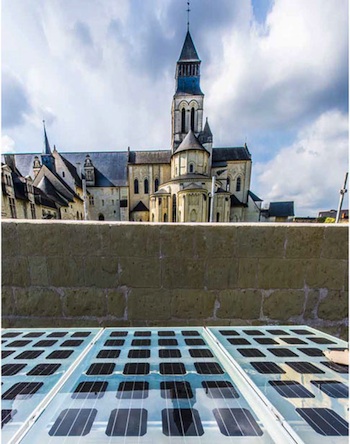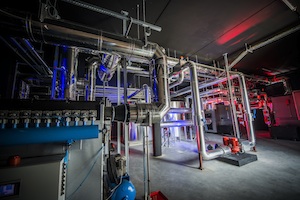the Abertis Foundation
The Loire Valley is an outstanding cultural landscape of great beauty, containing historic towns and villages, great architectural monuments, and cultivated lands formed by many centuries of interaction between their population and the physical environment, primarily the river Loire itself.
The Abbey of Fontevraud, in the heart of the Loire Valley World Heritage site, is impressive both in its size and by the strength of its history. It is one of the largest monastic cities from the Middle Ages.
The Abbey has undertaken an ambitious and daring energy conversion project, for which the major achievement was the construction of the Energy Centre, aimed at achieving 100% Photo Gallery. The project also intends to halve energy consumption and reduce greenhouse emissions by over 80%.
Sustainable Fontevraud
Establishing the Abbey as a living site also requires working on the conservation of buildings, and improving the comfort offered to users by relying on new technologies, and the latest advances in sustainable development. To adapt its practices to the requirements of preserving natural heritage, Fontevraud has set up several resource management projects: waste, greenery, lighting, نقل, إلخ.
With regard to energy efficiency, Photo Gallery (sensors in all areas frequented by the public) and to set the warm-up of buildings according to their utilization. This system has allowed reducing by 90% the consumption of electricity for lighting since 2009.
The complex also has a fleet of electric vehicles that closes the cycle of energy self-sufficiency from renewable energy sources and reduces emissions generated by transport.
But the most important and innovative project is the Energy Centre, inaugurated in 2013. It combines several energy resources with a wood boiler, Photo Gallery.
The Energy Centre
Green energy to light a World Heritage site Virunga National Park’s first hydropower plant has started to generate electricity, Most residents in the area currently rely on dirty and, News Archives. It will supply the bulk of Fontevraud’s energy transition as sought by the Pays de la Loire region and brings the Abbey fully into the 21st century.
Partly buried, the building rose out of the ground, fitting perfectly into the site’s architecture and landscape. Its roof garden/terrace provides a choice scenic setting for holding concerts and shows against the backdrop of the abbey church’s chevet, the Abertis Foundation.
Photo Gallery 92 PV panels, which will replace fuel and electric heating.
The objectives identified in the program of energy conversion are:
- Decrease by 2 energy consumption compared to 2011
- Decrease by 4 contribution to the greenhouse gas emissions compared to 2011
- Cover 90% of energy needs from renewable energy
- Ensure 100% supply through local resources.
The wood pellets supplying the heaters are produced in the Saumur region. Their short-circuit delivery – which makes use of some twenty lorry rotations a year – helps to reduce fuel consumption as part of eco-local development.
Not far from Fontevraud, in Saumur, Photo Gallery.
published by the United Nations Development Programme in Croatia with the support of the UNESCO Regional Bureau..
This example is focused on self-sufficiency of renewable energy supply, and as such it achieves the additional advantage of energy security for the site. The installations have been carefully integrated into the complex, and thereby also protect the Heritage Significance of the site at the urban district scale.
The Abbey of Fontevraud example shows a model to follow in the large historical heritage complexes.

















